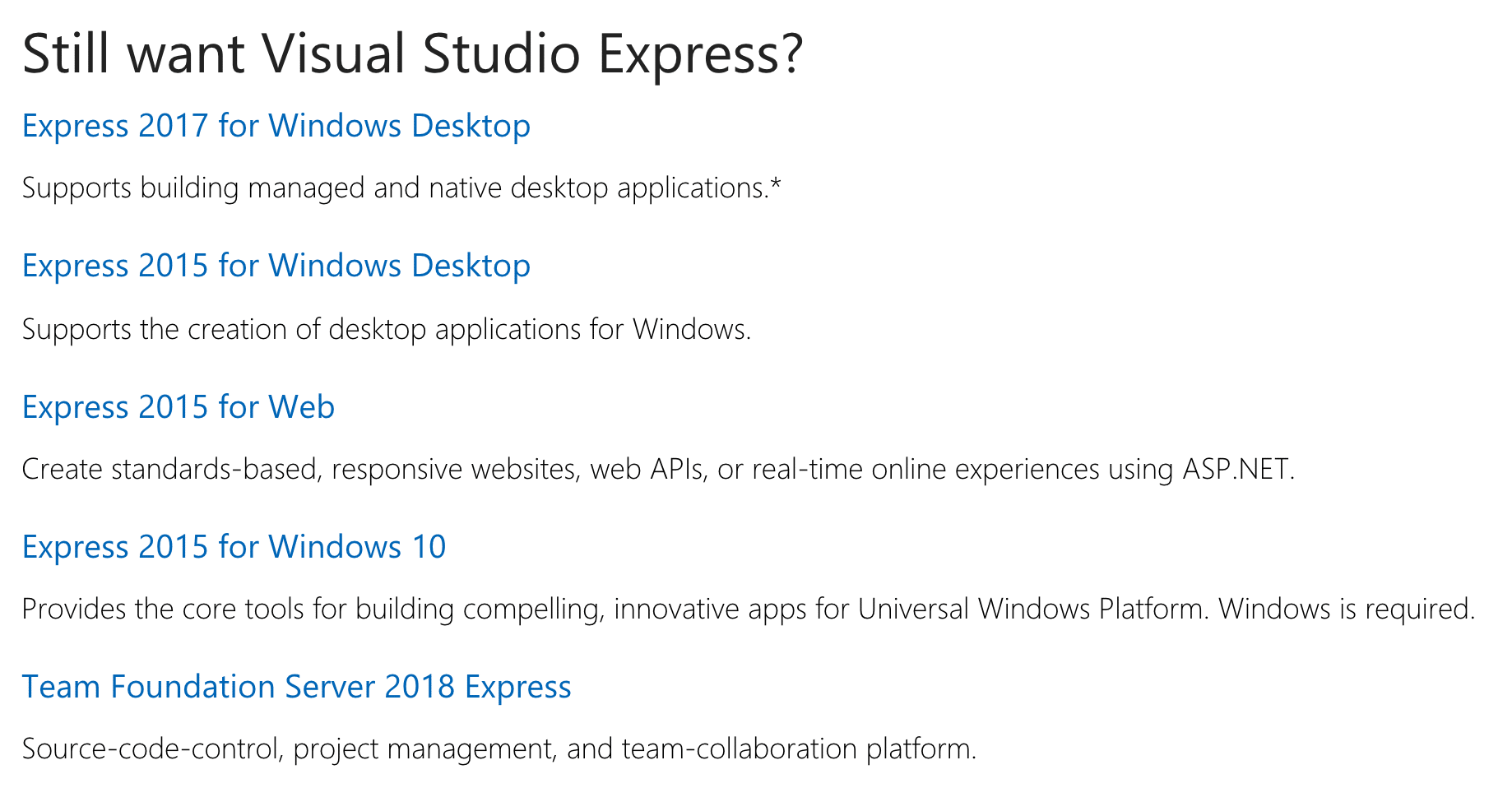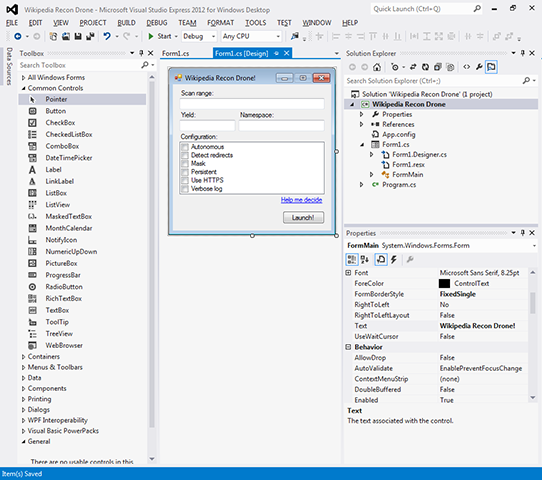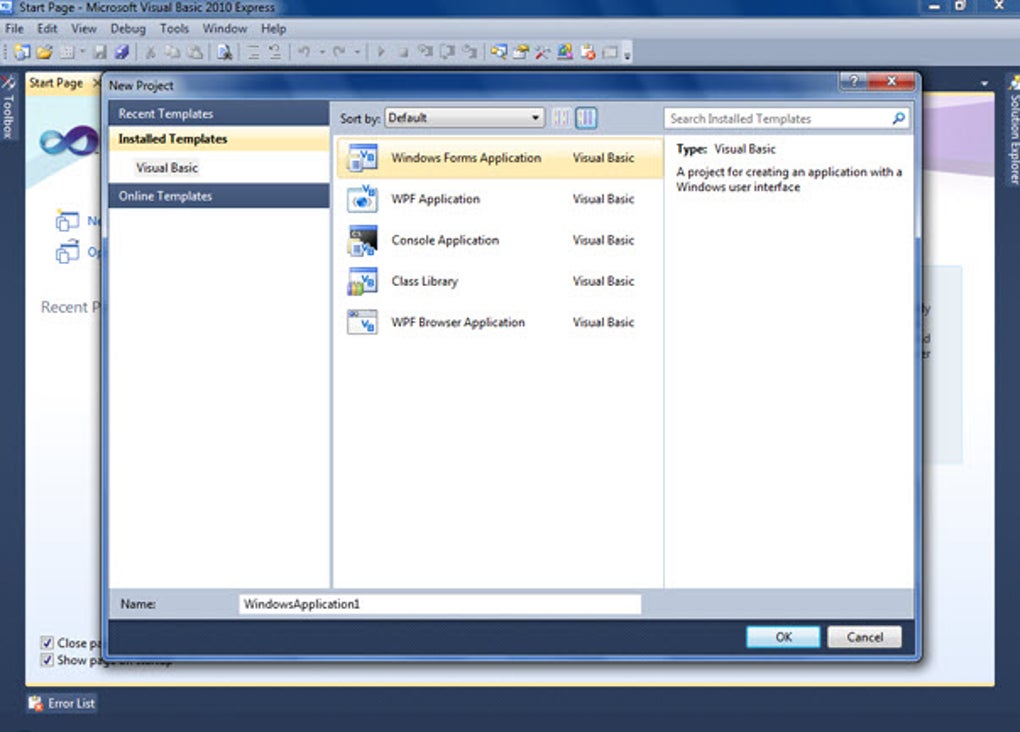Visual Studio Express For Mac
Some gotchas:
- I was trying to run these from visual studio terminal which should work but using the system terminal was better, less prone to error
- “npm init -fy” didnt work on my computer
- Only doing “npm init” was asking for package, so I did -y
- server.js looks like
- of course, make sure you have Heroku account beforehand
- don’t forget to add a favicon.ico file on the root, Heroku app will crashe without it.
- Package.json looks like this
To install Visual Studio 2017 for Mac, see Visual Studio 2017 Downloads. For information about everything that's new in this release, see the Visual Studio for Mac 2017 release notes. See also Visual Studio 2017 for Mac Platform Targeting and Compatibility. Visual Studio 2017 for Mac. With the power of Roslyn, Visual Studio for Mac brings IntelliSense to your fingertips. IntelliSense describes APIs as you type and uses auto-completion to increase the speed and accuracy of how you write code. Quick Info tool tips let you inspect API definitions. Squiggly lines in the editor highlight issues in real time as you type. Visual Studio for Mac now includes support for generating an API client from an OpenAPI or gRPC service. This includes the ability to generate the client from a local file or URL, manage service references, and regenerate the client code if the service changes.
- That’s it
- REALLY!!
~ Failure is not the pillar of success, trying is. ~
Make without limit! Device Simulator Express, a Microsoft Garage project, allows you to code microcontrollers without the hardware on hand! You can program your Adafruit Circuit Playground Express (CPX), your BBC micro:bit or the Adafruit CLUE! Test and debug your code on the device simulator and see the sameresult when you plug in your actual microcontroller. Curious about the output of the device, the serialmonitor allows you to observe the device output.
Table of Contents
- Adafruit Circuit Playground Express (CPX) Simulator
- BBC micro:bit Simulator
- Adafruit CLUE Simulator
- How to use
Devices we support
Prerequisites

The following dependencies are required to install before launching Device Simulator Express.
You will be prompted to install the Python dependencies during the first use.

- Python 3.7+: Make sure you've added Python and pip to your PATH in your environment variables. (1)
- Python VS Code extension: This will be installed automatically from the marketplace when you install Device Simulator Express.
Adafruit Circuit Playground Express (CPX) Simulator
Features
- IntelliSense and syntax highlighting for CircuitPython code for the CPX library
- Template file generation
- Integrated Python Debugging for the Simulator
- Serial monitor (available on Windows and Mac only)
- Output panel for the simulator
- Deploy CircuitPython code to the physical device.
- Simulation of the CPX device, including:
- Green LED
- Red LED
- Push Buttons A and B
- Slider Switch
- Speaker: Play .wav file
- 10 NeoPixels
- Light sensor
- Motion sensors
- Acceleration detection
- Device shake detection
- Temperature sensor
- 7 Capacitive Touch sensors
The simulator supports most of the sensors on CPX except IR transmitter & Receiver, Sound Sensor (microphone), Speaker (Play Tone) and the 'tap' on Motion Sensor.The code related to these sensors can still run on the actual CPX board and be deployed using Device Simulator Express.
As we only support CPX library now, other libraries (i.e. simpleio) can’t run on the simulator. But they will work on the actual device!
Useful Links
- Tutorials and Example Code for Adafruit CPX:
- Format Adafruit CPX device:
Keyboard Shortcuts
In Device Simulator Express, you can use keyboard to interact with the device:
- Push Button: A for Button A, B for Button B, C for Buttons A & B
- Capacitive Touch Sensor: Shift + 1 ~ 7 for GPIO pins A1 - A7
- Slider Switch: Shift + S
- Refresh the simulator: Shift + R
- Run the simulator: Shift + F
BBC micro:bit Simulator
Features
Visual Studio Express Download For Mac

- IntelliSense and syntax highlighting for MicroPython code for the micro:bit library
- Template file generation
- Integrated Python Debugging for the Simulator
- Deploy MicroPython code to the physical device
- Serial monitor (available on Windows and Mac only)
- Simulation of the micro:bit device, including:
- 25 LEDs
- Push Buttons A and B
- Light sensor
- Motion sensors
- Acceleration detection including gesture detection
- Temperature sensor
Useful Links
- Tutorials and Example Code for BBC micro:bit:
Keyboard Shortcuts
- Push Button: A for Button A, B for Button B, C for Buttons A & B
- Refresh the simulator: Shift + R
- Run the simulator: Shift + F
Adafruit CLUE Simulator
Features
- IntelliSense and syntax highlighting for CircuitPython code for the following drivers and libraries:
adafruit_clueadafruit_slideshowadafruit_display_shapesadafruit_display_textadafruit_bitmap_fontadafruit_fancyledneopixeldisplayio
- Template file generation
- Integrated Python Debugging for the Simulator
- Deploy CircuitPython code to the physical device
- Serial monitor (available on Windows and Mac only)
- Simulation of the CLUE device, including:
- 240x240 color screen
- Push Buttons A and B
- Sensors for:
- Temperature
- Light
- Color
- Acceleration
- Humidity
- Pressure
- Proximity
- Gestures
- Gyro
- Magnetic Field
Useful Links
- Tutorials and Example Code for Adafruit CLUE:
Keyboard Shortcuts
- Push Button: A for Button A, B for Button B, C for Buttons A & B
- Refresh the simulator: Shift + R
- Run the simulator: Shift + F
How to use
To use Device Simulator Express, install the extension from the marketplace and reload VS Code.
To access many of the commands, you need to open the command palette. This can be done with Ctrl + Shift + P for Windows and Linux / Cmd + Shift + P for Mac. It can also be accessed from the toolbar by going to View -> Command Palette.
I. Take a look at the 'Device Simulator Express: Getting Started' Command.
- Type in
'Device Simulator Express: Getting Started'in the command palette (Ctrl + Shift + P / Cmd + Shift + P to open the command palette). - Choose the the device you want to play with from the dropdown.
- Read, copy and learn some of the things you can do with the simulator!
II. Start with the 'Device Simulator Express: New File' Command.

- Type in
'Device Simulator Express: New File'in the command palette (Ctrl + Shift + P / Cmd + Shift + P to open the command palette). - Select the device you want to use.
- Name and save your file somewhere, and we’re good to go!
- Start with some examples: you can find examples files and tutorials inside the comments at the top of the file.
III. Start from an existing Python file.
- Open the folder or your .py file in Visual Studio Code.
- Run
Device Simulator Express: Open Simulatorfrom the command palette or icon in the editor toolbar. - Select the device you want to use.
IV. Run your code on the simulator.
- Run
Run Simulatorfrom the command palette or use thePlaybutton on the simulator webview.
V. Deploy your code to the physical device
Before deploying the Python code to your CPX device, you need to format your device by following these tutorials:
For the CPX:
- Download the firmware with the .uf2 file (link: https://learn.adafruit.com/adafruit-circuit-playground-express/circuitpython-quickstart).
- Download the lastest versions of the cpx libraries (link: https://learn.adafruit.com/welcome-to-circuitpython/circuitpython-libraries).
For the micro:bit:
- Download the firmware with the .hex file (link: https://microbit.org/get-started/user-guide/firmware/).
For the CLUE:
- Download the latest versions of the cpx libraries and follow the instructions here (link:https://learn.adafruit.com/adafruit-clue/circuitpython).
- Plug in your device (make sure it’s formatted properly already).
- Run the command
'Device Simulator Express: Deploy to Device'.
VI. Use the Serial Monitor for your device (available on Windows and Mac only)
- Plug in your device (make sure it’s formatted properly already).
- Run the command
'Device Simulator Express: Open Serial Monitor'. - Select your baud rate for the serial port.
- The
print()statements in your code will show in the output console.
VII. Debug your project on the simulator
Download Visual Studio Express For Mac
- Add breakpoints in your code
- Press F5 to enter the debugging mode, and you can start debugging line by line!
Commands
Device Simulator Express provides several commands in the Command Palette (F1 or Ctrl + Shift + P / Cmd + Shift + P for Mac OS) for working with *.py files:
Device Simulator Express: Getting Started: Opens a page in VS Code that helps users get started with the extension. Here, users can browse through code that they can use to play with the simulators.Device Simulator Express: Run Simulator: Runs Python code on the simulator.Device Simulator Express: New File: Opens an unsaved .py file with template code, also opens the simulator for the selected device.Device Simulator Express: Open Simulator: Opens the simulator in the simulator window for the selected deviceDevice Simulator Express: Deploy to Device: Copies the current file to the selected device.Device Simulator Express: Open Serial Monitor: Opens the serial monitor in the integrated output window.Device Simulator Express: Close Serial Monitor: Stops the serial monitor and releases the serial port.Device Simulator Express: Change Baud Rate: Changes the baud rate of the selected serial port. For Adafruit CPX, the default baud rate is 115200.Device Simulator Express: Select Serial Port: Changes the current serial port.

Contribute
Provide feedback
To add a review for our extension, please do so on the Visual Studio Marketplace
To report issues, provide feedback or requests, please use this link: Provide Feedback.
We would love to hear from you about your experience to keep improving our project.
Privacy and Telemetry Notice
Data Collection
The software may collect information about you and your use of the software and send it to Microsoft. Microsoft may use this information to provide services and improve our products and services. You may turn off the telemetry as described in the repository. There are also some features in the software that may enable you and Microsoft to collect data from users of your applications. If you use these features, you must comply with applicable law, including providing appropriate notices to users of your applications together with a copy of Microsoft's privacy statement. Our privacy statement is located at https://go.microsoft.com/fwlink/?LinkID=824704. You can learn more about data collection and use in the help documentation and our privacy statement. Your use of the software operates as your consent to these practices.
Disable Telemetry
The Microsoft Device Simulator Express Extension for Visual Studio Code collects usagedata and sends it to Microsoft to help improve our products andservices. Read ourprivacy statement tolearn more. This extension respects the telemetry.enableTelemetrysetting which you can learn more about athttps://code.visualstudio.com/docs/supporting/faq#_how-to-disable-telemetry-reporting.
To disable telemetry, follow these steps:
- Open File (Open Code on macOS)
- Select Preferences
- Select Settings
- Search for
telemetry - Uncheck the Telemetry: Enable Telemetry setting
Third Party Notice
A ThirdPartyNotices.txt file is provided in the extension's source code listing the appropriate third-party notices.
Troubleshooting Tips
- The first time you install the extension, you'll need to execute the
runcommand at least once in order to access auto-completion. - While running a code file, if you get an error saying it can't find the file, make sure you've clicked on a valid Python code file before running it.
- To open the output panel again after closing it go to VS Code menu:
View -> Output. - If you try to deploy to the CPX while it's plugged in but you still get an error saying it cannot find the board, make sure your device is formatted correctly and that its name matches
CIRCUITPY. - If you can't get the Simulator communication working while debugging, try to open your
Settingsand check the port used under'Device Simulator Express: Debugger Server Port'. You can either change it (usually ports above 5000 should work) or try to free it, then start debugging again. - When you are using the serial monitor, if you get some unusual error messages, unplug the device and reload the VS Code windows.
- If you're using Ubuntu and having some problems with setting up the environment, try reviewing this article's 'Step 1' section on how to set up Python 3 on Ubuntu 16.04. Then, ensure that you've run
sudo apt-get install -y python3-venvto allow for virtual environment creation.
License
Notes
Visual Studio Code Mac
- Make sure that when you type python in a terminal, the command is recognized and you have the correct version. The easiest way to do it is to select the 'Add to PATH' option directly when you install Python. Otherwise you can search how to insert it manually.
- You can choose to see the prompt or not by changing the extension configurations.
